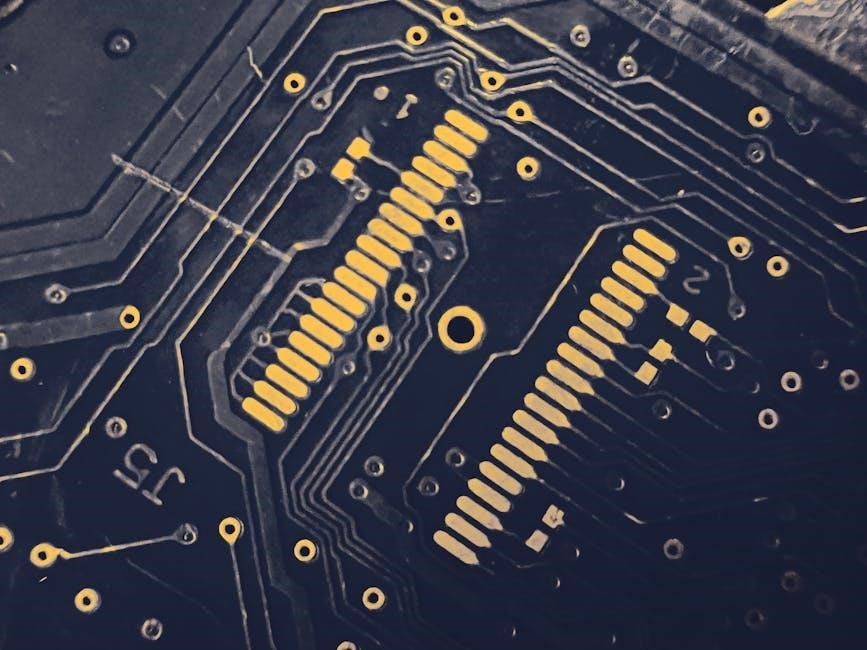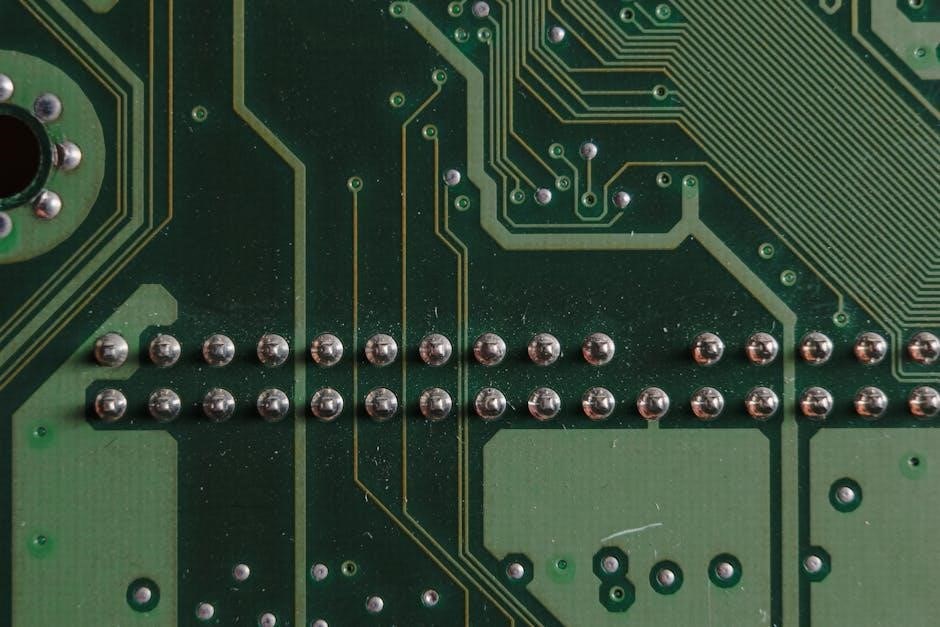Electrical and electronic symbols are essential for designing and interpreting circuit diagrams. They represent components like resistors, capacitors, and transistors, ensuring clarity in engineering projects. Standardized symbols, as per IEC 60617 and IEEE guidelines, facilitate universal understanding. These symbols are widely used in telecommunications, automotive electronics, and industrial automation. Resources like PDF guides and downloadable libraries simplify learning and application. Mastering these symbols is crucial for engineers, technicians, and students to communicate ideas effectively in electrical and electronic systems.
Overview of Electrical and Electronic Symbols
Electrical and electronic symbols are standardized representations used to depict components in circuit diagrams. They include elements like resistors, capacitors, inductors, and transistors, each with distinct visual representations. These symbols are essential for clear communication in engineering and design. Standards like IEC 60617 and IEEE ensure consistency across industries. Symbols are categorized into basic components, wiring, advanced devices, and control elements. They are widely used in telecommunications, automotive systems, and industrial automation. Resources such as PDF guides and downloadable libraries provide comprehensive lists for reference. Understanding these symbols is fundamental for interpreting and creating schematic diagrams efficiently.
Importance of Understanding Electrical and Electronic Symbols
Understanding electrical and electronic symbols is crucial for effective communication in engineering and electronics. These symbols serve as a universal language, enabling professionals to interpret and create circuit diagrams accurately. They ensure safety by providing clear instructions for component identification and connections. Engineers, technicians, and students rely on these symbols to design, troubleshoot, and maintain electrical systems. Misinterpretation can lead to system failures or safety hazards. Standardized symbols, as outlined in resources like PDF guides, promote consistency across industries. Mastery of these symbols enhances collaboration and efficiency in projects, making it a fundamental skill in electrical and electronic engineering.
Common Uses of Electrical and Electronic Symbols
Electrical and electronic symbols are widely used in creating schematic diagrams, which are essential for designing and repairing electronic circuits. These symbols are also employed in telecommunications, automotive electronics, and industrial automation. They serve as a common language for engineers and technicians, facilitating clear communication. Additionally, symbols are used in educational materials, such as PDF guides, to teach students about circuit components and their functions. They are also integral to wiring diagrams, helping professionals install and troubleshoot electrical systems safely. The use of standardized symbols ensures consistency and accuracy across various applications, making them indispensable in modern engineering and technology.

Basic Electrical and Electronic Components
Basic components include resistors, capacitors, inductors, transformers, diodes, and transistors. These elements form the foundation of electronic circuits, represented by standardized symbols for universal understanding and application.
Resistors and Their Symbols
Resistors are fundamental components in electronic circuits, opposing the flow of electric current. Their symbols vary: a zigzag line represents fixed resistors, while a zigzag with an arrow denotes potentiometers. Variable resistors, like rheostats, use a zigzag line with a diagonal arrow. Photoresistors, sensitive to light, are shown with a zigzag inside a circle. These symbols are standardized in electrical and electronic diagrams, ensuring clarity. They are crucial for voltage division, signal attenuation, and circuit protection. Understanding resistor symbols is essential for designing and interpreting circuit schematics, as outlined in resources like the IEC 60617 standard and downloadable PDF guides.
Capacitors and Their Symbols
Capacitors store electric energy in an electric field and are represented by distinct symbols. The standard symbol for a non-polarized capacitor is two parallel lines, while polarized capacitors include a plus sign (+) on the positive terminal. Variable capacitors are shown with an arrow indicating adjustability. Capacitors are essential for filtering, energy storage, and signal processing in circuits. Their symbols are standardized in electrical diagrams, ensuring universal understanding. Resources like PDF guides and downloadable libraries provide detailed representations of capacitor symbols, aiding engineers and technicians in circuit design and interpretation. These symbols are fundamental for accurately conveying capacitor functions in electronic schematics.
Inductors and Their Symbols
Inductors store energy in a magnetic field when current flows through a coiled conductor. Their symbol is a coil, often with two parallel lines at one end for fixed inductors. Variable inductors include an arrow or adjustable core. Iron-core inductors are shown with two parallel lines inside the coil. Air-core inductors omit these lines. These symbols are standardized in electrical diagrams, aiding in circuit design. Inductors are crucial for filtering, tuning, and managing voltage spikes. Resources like PDF guides and libraries provide detailed representations of inductor symbols, ensuring accuracy in schematics. Understanding these symbols is vital for engineers and technicians working with electronic circuits.
Transformers and Their Symbols
Transformers are represented by a symbol featuring two inductor coils (primary and secondary windings) separated by a vertical line. This line indicates the transformer’s ability to step up or step down alternating current (AC) voltage. The symbol may include additional elements, such as dots for polarity or an iron core for high-frequency applications. Air-core transformers omit the vertical line. Transformers are essential in power supplies, audio equipment, and telecommunication systems. Their symbols are standardized in PDF guides and libraries, ensuring consistency in circuit diagrams. Understanding transformer symbols is crucial for engineers designing electronic circuits, as they play a key role in voltage regulation and energy transfer.
Diodes and Their Symbols
A diode is represented by a symbol featuring an arrow pointing towards a vertical line, indicating the direction of conventional current flow. The arrowhead represents the anode, and the line denotes the cathode. Specialized diodes, such as zener, Schottky, and LED diodes, have modified symbols. For example, an LED diode includes arrows to signify light emission. Rectifier diodes are shown with a curved arrow. These symbols are standardized in resources like PDF guides and libraries, ensuring consistency in circuit diagrams. Diodes are crucial for applications like rectification, voltage regulation, and signal modulation. Understanding their symbols is essential for engineers and technicians working with electronic circuits.
Transistors and Their Symbols
Transistors are three-terminal semiconductor devices used for amplification and switching. Their symbols vary based on type, with the most common being Bipolar Junction Transistors (BJT) and Field-Effect Transistors (FET). The BJT symbol features a triangle pointing towards a line, representing the emitter, base, and collector. The direction of the triangle distinguishes NPN and PNP types. FET symbols include a circle with a line extending from it, indicating the gate, source, and drain. Power transistors and Darlington transistors have unique symbols to denote their specialized functions. These symbols are standardized in resources like PDF guides and libraries, aiding engineers in circuit design and troubleshooting. Understanding transistor symbols is crucial for working with electronic circuits.

Wiring and Circuit Symbols
Wiring and circuit symbols represent connections and components in electrical systems. They include wires, switches, fuses, and circuit breakers, essential for creating clear and accurate circuit diagrams.
Wires and Connections
Wires and connections are fundamental in electrical diagrams, representing conductors and pathways for current flow. Solid lines denote single wires, while dashed lines indicate connections on opposite sides of a board. Colors often code for voltage levels or phases, ensuring safety and clarity. Junctions and terminals are marked with distinct symbols, guiding technicians through circuit assembly. Proper representation of wires and connections is critical for troubleshooting and maintaining electrical systems, as incorrect symbols can lead to dangerous misunderstandings. Standardized symbols, as outlined in IEC and IEEE guidelines, ensure universal comprehension and efficient communication among engineers and technicians globally.
Switches and Relays
Switches and relays are essential control components in electrical circuits, represented by distinct symbols. Switch symbols vary, with SPST (single-pole, single-throw) and SPDT (single-pole, double-throw) being common types; Relays, denoted by a coil and movable contacts, act as electrically controlled switches. Normally open (NO) and normally closed (NC) contacts are clearly marked. These symbols are vital for designing and interpreting circuit diagrams, ensuring proper control of current flow. Standardized symbols, as per IEC 60617, facilitate universal understanding. Accurate representation of switches and relays is critical for troubleshooting and maintaining electrical systems, ensuring safe and efficient operation across various applications.
Fuses and Circuit Breakers
Fuses and circuit breakers are critical protective devices in electrical circuits, represented by unique symbols. A fuse is denoted by two diagonal lines in a rectangle, indicating its function to melt and break the circuit during overcurrent. Circuit breakers are shown as switches with a diagonal line, representing their role in automatically interrupting the circuit. Both symbols emphasize safety by preventing damage from overloads or short circuits. Standardized symbols, as per IEC 60617, ensure clarity. Understanding these symbols is essential for identifying protective mechanisms in circuit diagrams, enabling proper installation and troubleshooting. Their accurate representation ensures reliable operation and safety in electrical systems.
Plug and Socket Symbols
Plug and socket symbols are essential for representing power connections in electrical circuits. A plug is typically shown as prongs within a circle, while a socket is depicted as a circle or square with openings. These symbols indicate where devices connect to power sources. Standardized by IEC 60617, they ensure universal recognition. Their clear representation in wiring diagrams helps technicians identify proper connections. Understanding these symbols prevents incorrect wiring and enhances safety. They are crucial for designing and interpreting electrical systems, ensuring compatibility and functionality. Accurate use of plug and socket symbols is vital for maintaining reliable power distribution in circuits and devices.
Advanced Electrical and Electronic Symbols
Advanced symbols include logic gates, microcontrollers, and sensors, crucial for complex circuits. They represent digital components, enabling precise control in modern systems. These symbols are vital in telecommunications, automation, and embedded systems, ensuring functionality and integration. Understanding them is essential for designing advanced electronic circuits and systems. They are widely used in industrial automation, robotics, and IoT devices. Accurate representation of these symbols ensures seamless communication among engineers and technicians, facilitating innovation and efficiency in electronic designs.

Logic Gates and Their Symbols
Logic gates are fundamental components in digital electronics, represented by unique symbols. The basic gates include AND, OR, NOT, and their derivatives like NAND, NOR, XOR, and XNOR. Each symbol corresponds to specific boolean operations, enabling circuit design for complex digital systems. AND gates combine inputs to produce an output only when all inputs are true, while OR gates activate if any input is true. NOT gates invert the input, and XOR gates output true when inputs differ. These symbols are universally standardized, ensuring clarity in circuit diagrams. They are essential for designing microprocessors, memory chips, and programmable logic controllers; Understanding logic gate symbols is crucial for digital circuit design and troubleshooting.
Integrated Circuits and Their Symbols
Integrated circuits (ICs) are compact components containing multiple electronic circuits on a single chip of semiconductor material. Their symbols simplify complex functions into recognizable shapes, making circuit diagrams easier to interpret. Common symbols include rectangles with pin connections, representing microprocessors or memory chips. Specific ICs, like op-amps or timers, have distinct shapes with standardized pin configurations. These symbols are essential for designing and troubleshooting modern electronic systems. They enable engineers to quickly identify functions and connections, streamlining the design process. Resources like PDF guides provide detailed libraries of IC symbols, ensuring consistency across projects. Understanding these symbols is vital for working with advanced electronic systems and embedded technologies.
Microcontrollers and Their Symbols
Microcontrollers are advanced electronic components that integrate processing, memory, and input/output peripherals into a single chip. Their symbols in circuit diagrams are detailed, often represented by rectangular blocks with labeled pins for inputs, outputs, and power connections. These symbols are crucial for embedded systems design, allowing engineers to visualize and connect microcontroller functions within complex circuits. The symbols are standardized to ensure consistency across designs, making it easier to interpret and implement microcontroller-based systems. Resources like PDF guides and downloadable libraries provide comprehensive collections of these symbols, aiding in the creation of accurate schematic diagrams for various applications in robotics, automation, and IoT devices.
Sensors and Actuators
Sensors and actuators are vital components in electrical and electronic systems, enabling interaction with the physical world. Sensors detect parameters like temperature, pressure, or motion, while actuators execute actions such as opening valves or driving motors. Their symbols are standardized, with sensors often represented by simplified shapes indicating their function, such as a thermometer for temperature sensors. Actuators are depicted similarly, like a valve symbol for fluid control. These symbols are essential for designing automation and IoT systems, ensuring clarity in circuit diagrams. Resources like PDF guides provide detailed libraries of sensor and actuator symbols, aiding engineers in accurate schematic design and implementation across various applications.

Standards and Conventions
Standards and conventions ensure consistency in electrical and electronic symbol usage, facilitating universal understanding. They define rules for symbol design, application, and interpretation across various industries, including telecommunications and automotive electronics. Adherence to these standards minimizes errors and enhances collaboration among engineers globally.
IEC 60617 Standard for Electrical Symbols
The IEC 60617 standard provides a comprehensive set of graphical symbols for electrical and electronic diagrams. Published by the International Electrotechnical Commission (IEC), it ensures consistency and clarity in representing components like resistors, capacitors, and transistors. Widely adopted internationally, this standard helps engineers, technicians, and students communicate ideas effectively. It covers symbols for wires, switches, and complex devices, reducing errors in circuit design and interpretation. The standard is regularly updated to reflect technological advancements, with the latest version (0.3) available for examination since 2020. By following IEC 60617, professionals can create universally understandable schematic diagrams, fostering collaboration across industries.
IEEE Standards for Electronic Symbols
IEEE standards for electronic symbols provide a unified approach to representing components in electrical and electronic diagrams. Maintained by the Institute of Electrical and Electronics Engineers, these standards ensure accuracy and consistency in symbol usage. They cover a wide range of elements, from basic components like resistors and capacitors to advanced devices such as logic gates and microcontrollers. IEEE standards are widely adopted in industries like telecommunications, automotive electronics, and industrial automation. By adhering to these standards, engineers and technicians can create clear and unambiguous circuit diagrams, reducing errors and enhancing collaboration. These standards are regularly updated to reflect advancements in technology and are accessible through resources like PDF guides and downloadable libraries, making them indispensable for modern electrical and electronic engineering practices.
Common Conventions in Symbol Usage
Standardized conventions ensure consistency in symbol usage across electrical and electronic diagrams. Symbols are positioned to reflect their logical function, with arrows indicating direction of current or signal flow. Component labels are often placed adjacent to symbols for clarity. Standardized shapes and orientations help distinguish between similar components. Contextual placement within circuits avoids ambiguity, with symbols grouped by function. Industry-specific variations exist but generally align with global standards like IEC and IEEE. Adherence to these conventions enhances readability and ensures universal understanding, making diagrams accessible to engineers and technicians worldwide. Proper symbol usage is essential for accurate circuit interpretation and efficient collaboration in engineering projects.

Tools for Creating Electrical and Electronic Symbols
Popular tools include AutoCAD, KiCad, and Fritzing for designing schematics. Vector graphics tools like Adobe Illustrator are used for custom symbols. Online libraries provide pre-drawn symbols for efficiency.
Software for Drawing Schematic Diagrams
Software like AutoCAD, KiCad, and Fritzing are widely used for creating electrical and electronic schematics. AutoCAD offers advanced tools for precise designs, while KiCad is popular for open-source projects. Fritzing is ideal for prototyping and educational purposes. Eagle and Altium Designer are preferred for professional PCB design. OrCAD and LTspice are excellent for circuit simulations and analysis. These tools support standard symbol libraries, ensuring consistency and efficiency. Online platforms like draw.io and SmartDraw also provide user-friendly interfaces for quick diagram creation. Such software is indispensable for engineers, students, and hobbyists, enabling them to bring their ideas to life with accurate and professional-looking schematics.
Vector Graphics for Symbol Design
Vector graphics are essential for creating scalable and precise electrical and electronic symbols. Tools like Adobe Illustrator and Inkscape allow designers to craft symbols with clean lines and proportional accuracy. These graphics retain quality at any scale, making them ideal for diagrams, schematics, and technical documentation. Vector formats such as SVG and EPS are widely used for their flexibility and compatibility across platforms. Designers can easily edit and customize symbols without losing resolution, ensuring consistency and clarity in electrical and electronic representations. This method is particularly useful for creating standardized symbols that meet industry specifications, enhancing readability and professional presentation in engineering projects.
Online Libraries for Electrical Symbols
Online libraries offer a vast collection of electrical and electronic symbols, providing easy access for engineers and designers. Platforms like IEEE, IEC, and specialized websites host downloadable symbols in vector formats such as SVG and EPS. These libraries ensure standardization and consistency, adhering to industry guidelines. Users can efficiently search, download, and integrate symbols into their projects, saving time and improving workflow. Many libraries are free or royalty-free, making them accessible for educational and professional use. They cater to various fields, including telecommunications, automotive, and industrial automation, offering symbols for components like resistors, capacitors, and logic gates. These resources are invaluable for creating precise and professional schematic diagrams.

Applications of Electrical and Electronic Symbols
Electrical and electronic symbols are widely used in telecommunications, automotive electronics, and industrial automation. They facilitate circuit design, troubleshooting, and communication across engineering disciplines, ensuring precision and clarity.
Telecommunications and Networking
Electrical and electronic symbols play a crucial role in telecommunications and networking. They are used to represent components in circuit diagrams for routers, switches, and fiber optic systems. Symbols like those for wires, connectors, and logic gates help in designing and troubleshooting communication networks. These symbols ensure clarity in signal flow and network topology. Standardized symbols, as per IEC and IEEE guidelines, are essential for maintaining consistency across different manufacturers and systems. Engineers and technicians rely on these symbols to install, maintain, and repair telecommunication infrastructure. Resources like PDF guides and downloadable libraries provide comprehensive lists of symbols specific to telecommunications, aiding professionals in their work.
Automotive Electronics
Electrical and electronic symbols are vital in automotive electronics for designing and troubleshooting vehicle systems. Symbols for components like batteries, alternators, and sensors are standardized, ensuring clarity in circuit diagrams. These symbols, as per IEC 60617, help in understanding wiring harnesses and electronic control units. They are essential for modern vehicles, which rely heavily on advanced electronics for functions like engine control, infotainment, and safety systems. Engineers use these symbols to simplify complex systems, making repairs and upgrades more efficient. Resources like PDF guides provide detailed symbol libraries, aiding automotive technicians and engineers in their work. This ensures consistent and accurate communication across the industry.

Industrial Automation
Electrical and electronic symbols play a crucial role in industrial automation, enabling clear communication and efficient system design. Symbols for components like motors, programmable logic controllers (PLCs), sensors, and actuators are standardized, ensuring consistency across industries. These symbols, as outlined in IEC 60617, simplify the interpretation of complex control circuits and wiring diagrams. In industrial settings, they are essential for maintaining and troubleshooting automated systems, such as conveyor belts and robotic assemblies. Standardized symbols enhance collaboration among engineers and technicians, reducing errors and improving productivity. Resources like PDF guides provide comprehensive libraries of industrial automation symbols, aiding professionals in designing and optimizing automated processes efficiently.

Resources and Downloads
Access comprehensive PDF guides and downloadable symbol libraries for electrical and electronic symbols. These resources provide detailed diagrams, standards, and conventions for learning and professional use, ensuring accuracy and efficiency.
PDF Guides for Electrical and Electronic Symbols
PDF guides provide comprehensive resources for understanding electrical and electronic symbols. These documents include detailed diagrams, component listings, and explanations of standards like IEC 60617. Many guides, such as those from Cambridge IGCSE and the Institution of Electrical Engineers, offer printable versions for easy reference. They cover basic components like resistors and capacitors, as well as advanced symbols for logic gates and microcontrollers. These guides are invaluable for students, engineers, and technicians, ensuring accurate interpretation of circuit diagrams. They also often include vector graphics for clarity, making them versatile tools for both learning and professional use.
Downloadable Symbol Libraries
Downloadable symbol libraries offer extensive collections of electrical and electronic symbols in vector formats, ideal for schematic diagrams. Websites provide over 230,801 royalty-free vectors, including circuit elements like resistors, capacitors, and logic gates. These libraries are available in PDF and vector graphics, ensuring scalability and clarity. Engineers, designers, and educators can access these resources for projects, presentations, and educational materials. Libraries often include standardized symbols from IEC 60617 and IEEE, ensuring compliance with industry norms. Popular platforms like Pinterest and creative marketplaces offer these libraries for easy download, making them indispensable tools for professionals and students alike. They simplify the creation of precise and visually appealing diagrams.
Online Courses for Learning Symbols
Online courses provide comprehensive training in electrical and electronic symbols, offering structured learning for students and professionals. Platforms like Coursera, Udemy, and edX feature courses that cover fundamental symbols, circuit diagrams, and industry standards. These courses often include interactive quizzes, hands-on projects, and downloadable resources like PDF guides. Topics range from basic components to advanced logic gates and microcontrollers. Many courses are designed for self-paced learning, allowing learners to master symbols at their convenience. Additionally, certifications are available upon completion, enhancing credibility for engineers and technicians. These resources are invaluable for anyone seeking to deepen their understanding of electrical and electronic symbols.
Mastering electrical and electronic symbols is crucial for effective communication in engineering. These symbols, standardized by IEC 60617 and IEEE, enable precise circuit designs and troubleshooting. Resources like PDF guides and online courses simplify learning, ensuring professionals stay updated. As technology advances, understanding these symbols remains vital for innovation and collaboration in the field.
Electrical and electronic symbols are fundamental for creating and interpreting circuit diagrams. Common symbols include resistors, capacitors, inductors, transformers, diodes, and transistors, each representing specific functions. Standardized by IEC 60617 and IEEE, these symbols ensure universal understanding. They are categorized into basic components like wires, switches, fuses, and advanced elements such as logic gates and microcontrollers. Symbols for sensors, actuators, and integrated circuits are also essential. These representations enable clear communication among engineers and technicians, simplifying the design, analysis, and troubleshooting of electrical and electronic systems. Resources like PDF guides and downloadable libraries provide comprehensive lists for reference, aiding in both education and professional applications.
Future Trends in Electrical and Electronic Symbol Usage
The future of electrical and electronic symbol usage is poised for innovation, driven by advancements in technology and design tools. Expect increased adoption of vector graphics and 3D modeling for enhanced precision. Standardized libraries will integrate seamlessly with CAD software, streamlining design processes. AI-driven tools will simplify symbol creation and customization. IoT and smart systems will expand the need for new symbols, reflecting emerging technologies. Collaboration between standards organizations will ensure global consistency. As electronics evolve, so too will the symbols, adapting to new components and applications while maintaining clarity and universality in communication among engineers and designers.

Final Thoughts on the Importance of Symbols
Electrical and electronic symbols are the backbone of technical communication in engineering. They ensure clarity, precision, and safety in designing and interpreting circuits. Universal standards like IEC 60617 and IEEE enable global understanding, fostering collaboration across industries. Symbols transcend language barriers, making complex ideas accessible worldwide. Their proper use is critical for avoiding errors and ensuring system functionality. As technology advances, mastering these symbols remains essential for engineers, technicians, and students. Resources like PDF guides and online courses provide convenient learning tools. Ultimately, the accurate understanding and application of electrical and electronic symbols are fundamental to driving innovation and ensuring the success of modern technological projects.
